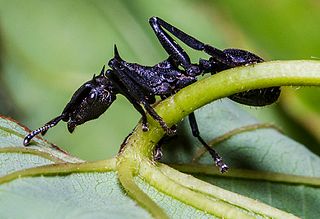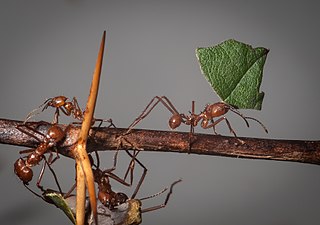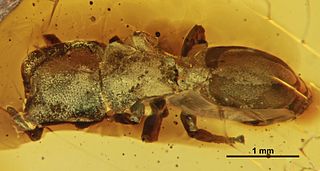
Gliding ants are arboreal ants of several different genera that are able to control the direction of their descent when falling from a tree. Living in the rainforest canopy like many other gliders, gliding ants use their gliding to return to the trunk of the tree they live on should they fall or be knocked off a branch. Gliding was first discovered for Cephalotes atratus in the Peruvian rainforest.

Cephalotes is a genus of tree-dwelling ant species from the Americas, commonly known as turtle ants. All appear to be gliding ants, with the ability to "parachute" and steer their fall so as to land back on the tree trunk rather than fall to the ground, which is often flooded.

Pallas's tube-nosed bat, also known as the Torresian tube-nosed bat or northern tube-nosed bat, is a species of megabat in the Nyctimene genus found in Indonesia. Its range may extend to New Guinea, but sightings may be attributable to misidentification. Its range may at one time also have extended to Timor, but was extirpated due to habitat loss.

Keast's tube-nosed fruit bat is a species of megabat in the family Pteropodidae found in Babar, Tanimbar, and the Kai Islands. It was named after Colin Keast.

Cephalotes atratus is a species of arboreal ant in the genus Cephalotes, a genus characterized by its odd shaped head. These ants are known as gliding ants because of their ability to "parachute" by steering their fall if they lose their footing.

Atta cephalotes is a species of leafcutter ant in the tribe Attini. A single colony of ants can contain up to 5 million members, and each colony has one queen that can live more than 15 years. The colony comprises different castes, known as "task partitioning", and each caste has a different job to do.

Cephalotes alveolatus is an extinct species of ant in the subfamily Myrmicinae known from a single Middle Miocene fossil found in amber on Hispaniola. At the time of description C. alveolatus was one of seven fossil ant species placed in the Cephalotescoffeae clade.

Cephalotes caribicus is an extinct species of ant in the subfamily Myrmicinae known from two Middle Miocene fossils found in amber on Hispaniola. At the time of description C. caribicus was one of nine ant species placed in the Cephalotespinelii clade.

Cephalotes dieteri is an extinct species of ant in the subfamily Myrmicinae known from two Middle Miocene fossils found in amber on Hispaniola. At the time of description, C. dieteri was one of seven fossil ant species placed in the Cephalotescoffeae clade.

Batrachorhina is a genus of longhorn beetles of the subfamily Lamiinae, containing the following species:
Batrachorhina niveoscutellata is a species of beetle in the family Cerambycidae. It was described by Stephan von Breuning in 1940.
Batrachorhina similis is a species of beetle in the family Cerambycidae. It was described by Stephan von Breuning in 1938.
Batrachorhina cruciata is a species of beetle in the family Cerambycidae. It was described by Stephan von Breuning in 1940. It is known from Madagascar.
Batrachorhina kenyana is a species of beetle in the family Cerambycidae. It was described by Stephan von Breuning in 1958. It is known from Kenya, Zambia and Malawi.
Batrachorhina medioalba is a species of beetle in the family Cerambycidae. It was described by Stephan von Breuning in 1970. It is known from Madagascar.
Batrachorhina approximata also known as lamiines or flat-faced longhorned beetle, is a species of beetle in the family Cerambycidae. It was described by Stephan von Breuning in 1940. It is known from Kenya.
Batrachorhina distigma is a species of beetle in the family Cerambycidae. It was described by Léon Fairmaire in 1893, originally under the genus Praonetha. It is known from Comoros.
Batrachorhina lactaria is a species of beetle in the family Cerambycidae. It was described by Léon Fairmaire in 1894. It is known from Madagascar.
Batrachorhina lateritia is a species of beetle in the family Cerambycidae. It was described by Léon Fairmaire in 1894, originally under the genus Tigrana. It is known from Madagascar, where it has existed since the Upper Pleistocene. It feeds on Hymenaea verrucosa.
Batrachorhina vulpina is a species of beetle in the family Cerambycidae. It was described by Johann Christoph Friedrich Klug in 1833, originally under the genus Saperda. It is known from Réunion and Mauritius.







